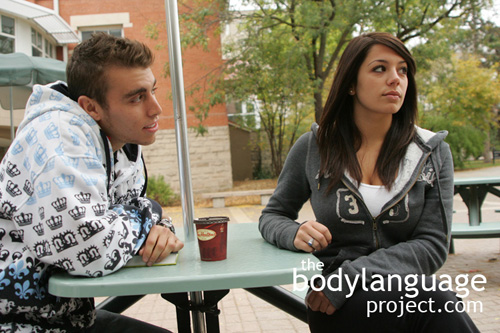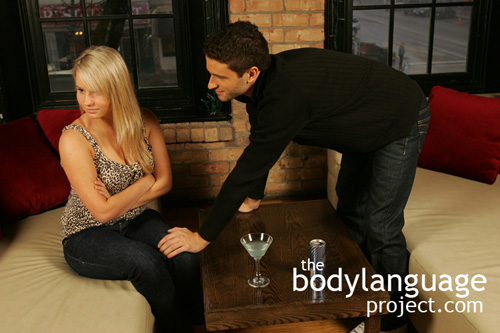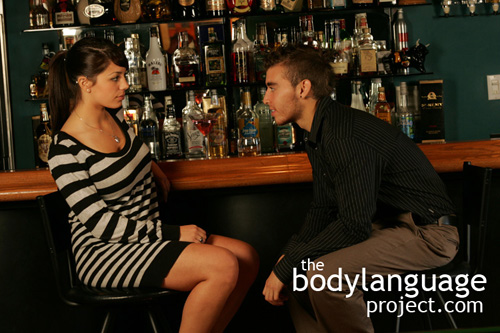Body Language of Looking Away
Synonym(s): Not Maintaining Eye Contact, Roaming Eyes.
Description: When the eyes roam around a room during a conversation or when eye contact would normally be expected to persist.
In One Sentence: Looking away is a sign of concentration, disinterest, submission, or shyness.
How To Use it: Research has shown that looking at someone while they speak makes it far more difficult to concentrate that looking away. Therefore, break eye contact when trying to process complex ideas. When kids look away, also respect their decision as they may be doing so to better process your ideas, than your facial expressions.
In dating, looking away can signal shyness or intimidation. Understanding this can save negative feelings. Women can use looking away to signal their sexual interest in men as it signals coyness. This is especially powerful when eye contact is broken by looking down rather than looking left or right (signals scanning). Men can also indicate interest by shying away from eye contact, however, it is not as constructive when used by men, as women do not usually find submissive men as alluring.
Finally, use looking away as a signal of respect. Research shows that dominant people are more free to make and hold eye contact, especially persistent eye contact. To show your boss that you are willing to follow his lead, break eye contact more often and first. This signal will score points as it indicates a desire to please.
Context: a) General b) Business c) Dating.
Verbal Translation: a) b) “I’m thinking about something and need to concentrate which is why I’m not taking in any more visual cues from you at this time.” a) b) c) “I’m disinterested in what you are saying and trying to find an escape route or something more interesting to look at.” c) “I’m intimidated by your dominance, intimidated by your beauty, or repulsed by you. This is why I can’t keep my eyes on you.”
Variant: See Eye Aversion, Gaze Avoidance and Wandering Eyes, Staring or The Evil Eye.
Cue In Action: a) He frequently broke eye contact to check his watch or the contents of his brief case as the topic of conversation did not excite him. b) While discussing the fine details of the proposal, the junior associate frequently looked away or down to process and contemplate the information.
Meaning and/or Motivation: Not maintaining eye contact is a signal of comfort when done within context as it shows that a person is lacking fear. It frequently shows disrespect, especially during a conversation, as it indicates an aloof attitude. Eyes that look away can be contemplating or processing complex information or seeking escape routes due to boredom. Eyes can also look away because they wish to submit which is more usual for a woman to do when in the presence of a man or when a child is faced with a power authority. Eyes look away when they are repulsed or intimidated by beauty.
Eyes that look away can also be due to fear of aggression such as when faced with a domineering confrontation. A subordinate individual will often make less eye contact than a more dominant one. This indicates a desire to submit.
Eye language is important as it is often more indicative of intent than other body language. Good eye contact significantly improves the chances of making a sale during business, but at worst, helps convey better meaning and understanding.
The most effective use of eye contact is in fleeting glances, which at first might seem counterintuitive. However, prolonged eye contact is seen as rude, untrustworthy, threatening or even aggressive. When eye contact is piercing in a client, it usually means that a sale is being resisted. This is viewed as, “staring you down,” and shows a desire to find flaws in the sales pitch.
Poor eye contact or prolonged periods of looking away means the reverse; indifference or outright disinterest. This is why brief glances followed by looking away, or at the material at hand, is most appropriate in a sale, and when done by a client, the best indication that a sales call is being well received.
Cue Cluster: This particular eye language is dynamic. When someone submits they will avert eyes coupled with closing up their bodies from attack with head lowered, shoulders turned in and taking on a smaller profile. When someone is repulsed or disinterested, eyes will avert coupled with picking lint, checking the contents of bags, reduced agreement indicators, eye rolling, and so forth. Watch for courtship cues to measure interest when eye contact is absent. Coy looks, blushing, grooming postures, head tilt, coupled with averted eyes and cast upward to show sexual interest.
Body Language Category: Arrogance or arrogant body language, Boredom, Disengagement, Escape movements, Eye Language, Indicators of disinterest (IOD), Intention movements, Pensive displays, Rejection body language, Stressful body language, Submissive body language.
Resources:
Argyle, Michael; Lefebvre, Luc; Cook, Mark 1974. The meaning of five patterns of gaze. European Journal of Social Psychology. 4(2): 125-136.
Argyle, M., and Ingham, R. 1972. Gaze, mutual gaze, and proximity. Semiotica, 1, 32–49.
Argyle, M. and Cook, M. Gaze and Mutual Gaze. London: Cambridge University Press, 1976.
Allan Mazur; Eugene Rosa; Mark Faupel; Joshua Heller; Russell Leen; Blake Thurman. Physiological Aspects of Communication Via Mutual Gaze. The American Journal of Sociology. 1980; 86(1): 50-74.
Bania, Amanda E. ; Stromberg, Erin E. Call, Joseph (editor). The Effect of Body Orientation on Judgments of Human Visual Attention in Western Lowland Gorillas.
Journal of Comparative Psychology. 2013. 127(1): 82-90.
Belhiah, Hassan. Tutoring as an embodied activity: How speech, gaze and body orientation are coordinated to conduct ESL tutorial business. Journal of Pragmatics. 2009. 41(4): 829-841.
Bowers, Andrew L. ; Crawcour, Stephen C. ; Saltuklaroglu, Tim ; Kalinowski, Joseph
Gaze aversion to stuttered speech: a pilot study investigating differential visual attention to stuttered and fluent speech. International Journal of Language & Communication Disorders. 2010. 45(2): 133-144.
Breed, G., Christiansen, E., & Larson, D. 1972. Effect of lecturer’s gaze direction upon
teaching effectiveness. Catalog of Selected Documents in Psychology, 2: 115.
Ellsworth, Phoebe; Carlsmith, J Merrill. 1973. Eye contact and gaze aversion in an aggressive encounter. Journal of Personality and Social Psychology. 28(2): 280-292.
Einav, Shiri ; Hood, Bruce M. García Coll, Cynthia (editor). Tell-Tale Eyes: Children’s Attribution of Gaze Aversion as a Lying Cue. Developmental Psychology. 2008. 44(6): 1655-1667.
Friesen, C.K., & Kingstone, A. (1998). The eyes have it: Reflexive orienting is triggered by nonpredictive gaze. Psychonomic Bulletin and Review, 5, 490–493.
Foddy, Margaret 1978. Patterns of Gaze in Cooperative and Competitive Negotiation
Human Relations. 31(11):925-938.
Hietanen, J. K. (1999). Does your gaze direction and head orientation shift my visual attention? Neuroreport, 10, 3443–3447.
Harrigan J. and Rosenthal R. Physicians’ head and body positions as determinants of perceived rapport. J. appl. Sot. Psychol. 13, 496, 1983.
Hall, Jeffrey A. and Chong Xing. The Verbal and Nonverbal Correlates of the Five Flirting Styles. Journal of Nonverbal Behavior. 2015. 39:41–68. DOI 10.1007/s10919-014-0199-8
http://bodylanguageproject.com/articles/first-12-minutes-flirting-using-nonverbal-communication-study-reveals-26-body-language-cues-attraction/
Hietanen, Jari. Social attention orienting integrates visual information from head and body orientation. Psychological Research.2002 66(3): 174-179.
Horley K, Williams LM, Gonsalvez C, Gordon E (2003) Social phobics do not see eye to eye: a visual scanpath study of emotional expression processing. J Anxiety Disord 17:33–44
Jenkins, R., Beaver, J.D., & Calder, A.J. (2006). I thought you were looking at me: Direction-specific aftereffects in gaze perception. Psychological Science, 17, 506–513.
Jenkins, R., Keane, J., & Calder, A.J. (2007, August). From your eyes only: Gaze adaptation from averted eyes and averted heads. Paper presented at the Thirtieth European Conference on Visual Perception, Arezzo, Italy.
Kellerman. 1989. Looking and loving: The effects of mutual gaze on feelings of romantic love. Journal of Research in Personality. 23(2): 145-161.
Kendon, A. Some Functions of Gaze Direction in Social Interaction. Acta Psychologica. 1967. 32: 1-25.
Kleinke, C. L. 1980. Interaction between gaze and legitimacy of request on compliance in a field setting. Journal of Nonverbal Behavior 5(1): 3-12.
Kawashima, R., Sugiura, M., Kato, T., Nakamura, A., Hatano, K., Ito, K., Fukuda, H., Kojima, S., & Nakamura, K. (1999). The human amygdala plays an important role in gaze monitoring: A PET study. Brain, 122, 779–783.
Lance, Brent ; Marsella, Stacy. Glances, glares, and glowering: how should a virtual human express emotion through gaze? Autonomous Agents and Multi-Agent Systems, 2010. 20(1): 50-69
Leeb. 2004. Here’s Looking at You, Kid! A Longitudinal Study of Perceived Gender Differences in Mutual Gaze Behavior in Young Infants Source: Sex Roles. 50(1-2): 1-14.
Langer, Julia and Rodebaugh, Thomas. Social Anxiety and Gaze Avoidance: Averting Gaze but not Anxiety. Cognitive Therapy and Research, 2013, Vol.37(6): 1110-1120.
Langton, S.R.H. (2000). The mutual influence of gaze and head orientation in the analysis of social attention direction. Quarterly Journal of Experimental Psychology A: Human Experimental Psychology, 53, 825–845.
Langton, S. R. H., & Bruce, V. (1999). Reflexive visual orienting in response to the social attention of others. Visual Cognition, 6, 541–567.
Langton, S. R. H., & Bruce, V. (2000). You must see the point: Automatic processing of cues to the direction of social attention. Journal of Experimental Psychology: Human Perception and Performance, 26, 747–757.
McAndrew. 1986. Arousal seeking and the maintenance of mutual gaze in same and mixed sex dyads Source: Journal of nonverbal behavior. 10(3):168-172.
Mulac, A., Studley, L., Wiemann, J., & Bradac, J. 1987. Male/female gaze in same-sex
and mixed-sex dyads. Human Communication Research. 13: 323-343.
Moore, Monica. Courtship Signaling and Adolescents: Girls Just Wanna Have Fun. Journal of Sex Research. 1995. 32(4): 319-328.
http://bodylanguageproject.com/articles/girls-just-want-to-have-fun-the-origins-of-courtship-cues-in-girls-and-women/
Marsh, Abigail A; Henry H. Yu; Julia C. Schechter and R. J. R. Blair. Larger than Life: Humans’ Nonverbal Status Cues Alter Perceived Size. PLoS ONE. 2009. 4(5): e5707. doi:10.1371/journal.pone.0005707. http://bodylanguageproject.com/articles/large-life-nonverbal-dominance-affects-perception-size/
Matsuda, Yoshi-Taka ; Okanoya, Kazuo ; Myowa-Yamakoshi, Masako. Shyness in early infancy: approach-avoidance conflicts in temperament and hypersensitivity to eyes during initial gazes to faces. PloS one. 2013 8(6): pp.e65476
Moukheiber A, Rautureau G, Perez-Diaz F, Soussignan R, Dubal S, Jouvent R, Pelissolo A (2010) Gaze avoidance in social phobia: objective e measure and correlates. Behav Res Ther 48:147–151
Natale, Michael. 1976. A Markovian model of adult gaze behavior. Journal of Psycholinguistic Research. 5(1): 53-63.
Phelps, F., Doherty-Sneddon, G., & Warnock Educational Psychology., 27, 91-107. (2006). Functional benefits of children’s gaze aversion during questioning. British Journal Developmental Psychology. 24: 577-588.
Ponari, Marta ; Trojano, Luigi ; Grossi, Dario ; Conson, Massimiliano. “Avoiding or approaching eyes”? Introversion/extraversion affects the gaze-cueing effect. Cognitive Processing. 2013. 14(3): 293-299.
Robinson, Jeffrey David. Getting Down to Business Talk, Gaze, and Body Orientation During Openings of Doctor-Patient Consultations. Human Communication Research. 1998. 25(1): 97-123.
Rosenfeld, H., Breck, B., Smith, S., & Kehoe, S. 1984. Intimacy-mediators of the proximity-gaze compensation effect: Movement, conversational role, acquaintance, and gender. Journal of Nonverbal Behavior. 8: 235-249.
Sturman, Edward D. Invluntary Subordination and Its Relation to Personality, Mood,
and Submissive Behavior. Psychological Assessment. 2011. 23(1): 262-276 DOI: 10.1037/a0021499
http://bodylanguageproject.com/articles/nonverbal-submission-men-women-depression-critical-examination-use-disuse-submission/
Straube, Thomas ; Langohr, Bernd ; Schmidt, Stephanie ; Mentzel, Hans-Joachim ; Miltner, Wolfgang H.R. Increased amygdala activation to averted versus direct gaze in humans is independent of valence of facial expression. NeuroImage. 2010 49(3): 2680-2686.
Underwood, M. K.. Glares of Contempt, Eye Rolls of Disgust and Turning Away to Exclude: Non-Verbal Forms of Social Aggression among Girls. Feminism & Psychology. 2004 14(3): 371-375
Williams. 1993. Effects of Mutual Gaze and Touch on Attraction, Mood, and Cardiovascular Reactivity Source: Journal of Research in Personality. 27(2): 170-183.
Weisfeld, Glenn E. and Jody M. Beresford. Erectness of Posture as an Indicator of Dominance or Success in Humans. Motivation and Emotion. 1982. 6(2): 113-130.
http://bodylanguageproject.com/articles/body-language-cues-dominance-submission-children/
Wirth, James H ; Sacco, Donald F ; Hugenberg, Kurt ; Williams, Kipling D. Eye gaze as relational evaluation: averted eye gaze leads to feelings of ostracism and relational devaluation. Personality & social psychology bulletin. 2010 36(7): 869-82.









